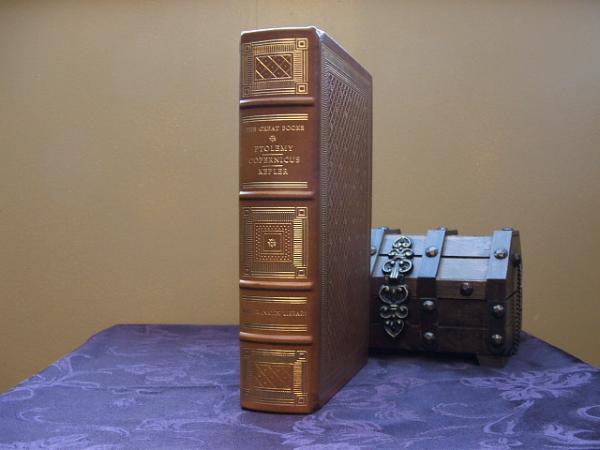Easton Press Nicolaus Copernicus books
De Revolutionibus Orbium Coelestium - 1999
Franklin Library Nicolaus Copernicus books
Works of Nicolaus Copernicus, Johannes Kepler and Ptolemy - Great Books of the Western World - 1985
(This page contains affiliate links for which we may be compensated.)
Who was Nicolaus Copernicus?
Nicolaus Copernicus, born on February 19, 1473, in Toruń, Royal Prussia, Poland, was a Renaissance mathematician and astronomer whose groundbreaking work revolutionized the understanding of the cosmos and laid the foundation for modern astronomy. His most famous contribution, outlined in his seminal work De revolutionibus orbium coelestium (On the Revolutions of the Celestial Spheres), challenged the prevailing geocentric model of the universe. Copernicus came from a well-to-do family and received an extensive education. He studied at the University of Kraków and later in Italy, where he immersed himself in the classical works of ancient scholars. His intellectual pursuits extended beyond astronomy to include medicine, mathematics, and economics. While serving as a canon and physician in the diocese of Warmia, Copernicus began developing his heliocentric model of the solar system, challenging the widely accepted Ptolemaic system that placed the Earth at the center of the universe. According to Copernicus, the Earth and other planets orbited the Sun, a concept that revolutionized the understanding of celestial mechanics.Copernicus worked on his revolutionary ideas for many years, but he hesitated to publish them due to the potential controversy and opposition from the prevailing scientific and religious authorities. Eventually, encouraged by fellow astronomers and scholars, he published De revolutionibus in 1543, just before his death. Despite the radical nature of his heliocentric theory, Copernicus did not witness severe backlash during his lifetime. The full impact of his work unfolded in the decades and centuries that followed, as other astronomers, such as Johannes Kepler and Galileo Galilei, built upon his ideas and advanced the heliocentric model.
Nicolaus Copernicus passed away on May 24, 1543, in Frombork, Poland. Although he did not live to see the profound impact of his contributions on scientific thought, his heliocentric model laid the groundwork for the Scientific Revolution and the subsequent transformation of our understanding of the cosmos. Copernicus's legacy endures as a symbol of scientific courage, intellectual inquiry, and the capacity of a single individual to reshape humanity's understanding of the universe.
Nicolaus Copernicus Accomplishments
Nicolaus Copernicus made several significant contributions to the fields of astronomy, mathematics, and science. The following are some of his key accomplishments.Heliocentric Model
Copernicus proposed the heliocentric model of the solar system, challenging the geocentric model that positioned the Earth at the center. In his work De revolutionibus orbium coelestium (On the Revolutions of the Celestial Spheres), published in 1543, Copernicus detailed the idea that the Earth and other planets orbit the Sun. This groundbreaking heliocentric model laid the foundation for the modern understanding of the solar system.Orbital Theory
Copernicus introduced a mathematical description of the planetary orbits. He proposed that planets move in orbits that are not perfect circles but are instead based on combinations of circles, known as epicycles, to account for the observed motions of celestial bodies. Although later astronomers like Kepler refined these ideas, Copernicus initiated a shift toward more accurate mathematical representations.Rotation of the Earth
Copernicus suggested that the Earth rotates on its axis, providing an explanation for the apparent daily motion of celestial bodies across the sky. This idea contributed to the eventual acceptance of the heliocentric model.Catalog of Stars
Copernicus compiled a catalog of over 1,000 stars, listing their positions and magnitudes. While his observations were not as accurate as those made with later telescopes, his catalog was a significant contribution to the understanding of the night sky.Mathematical Contributions
Copernicus made important mathematical contributions, including his work on trigonometry and his development of a system for expressing large numbers using a positional notation similar to modern decimal notation.Influence on Later Astronomers
Copernicus's heliocentric model influenced subsequent astronomers, such as Johannes Kepler and Galileo Galilei, who further developed and refined the heliocentric theory. Kepler's laws of planetary motion and Galileo's telescopic observations provided additional evidence in support of Copernicus's model.Nicolaus Copernicus's work laid the groundwork for the Scientific Revolution, challenging long-held beliefs about the structure of the universe. His contributions marked a turning point in the history of science, setting the stage for the advancements that followed in astronomy and physics.
